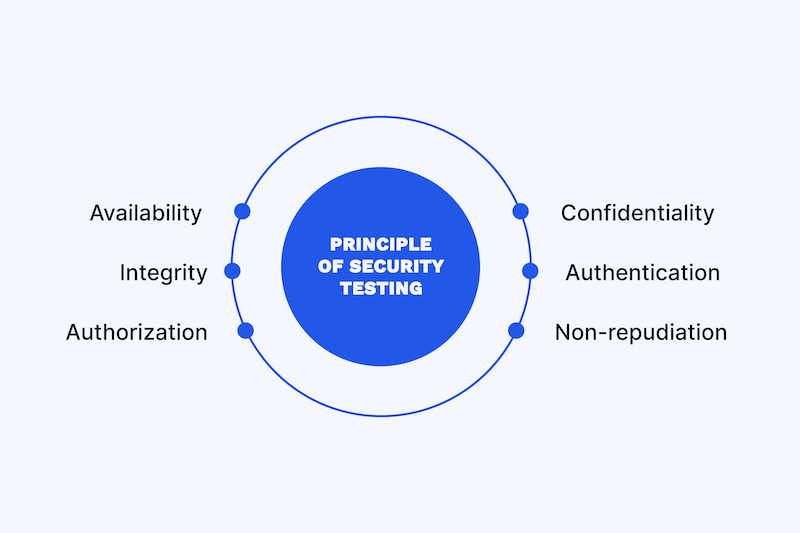
Contact us
Our team would love to hear from you.

Security testing can be thought of as a controlled attack on a system that identifies vulnerabilities or bottlenecks in the security of the system (in this case, an application). Also known as penetration testing or ethical hacking, security testing aims at assessing the current state of the system. One of the key goals is to identify all the security issues to help ensure that the system does not stop operating. This is where knowledge of testing theory, application behavior, human psychology, and common computer errors intersect.
Security testing is an essential part of software testing, and it is used to:
As a rule, the following features and procedures are subject to verification:
Access Control. Testing identifies problems related to unauthorized access of users to information and functions, depending on the granted role.
Authentication. A QA engineer makes sure that there is no way to bypass the registration and authorization procedure, ensures that user data is managed correctly, and excludes the possibility of obtaining information about registered users and their credentials.
Input value validation. QA security testing is used to check data processing algorithms, including incorrect values, before they are referenced by the system.
Cryptography. Testing may detect problems related to encryption, decryption, signing, authentication, including the level of network protocols, work with temporary files and cookies.
Error handling mechanisms. Testing is aimed at checking system errors for the absence of the fact of disclosing information about internal security mechanisms.
Server configuration. A QA engineer searches for errors in multithreaded processes related to the availability of variable values for sharing with other applications and requests.
Integration with third-party services. Security testing verifies that it is impossible to manipulate data transmitted between the application and third-party components, for example, payment systems.
Dos/DDos resiliency check. A QA expert checks the ability of an application to handle unplanned high loads and high volume.
Let’s consider the value of security testing utilization from the web applications possible security issues.

Principles of security testing for software development
The overall security strategy is based on the following six principles:
Confidential information is not intended to be passed on to any third parties. Confidentiality aims at protecting the interests of the stakeholders by preventing unauthorized leakage of information.
Integrity ensures that the data is accurate and consistent and has not been altered or modified.
Accessibility refers to the ability to access information any time it is needed. In case of data breach, it is useful to have a data availability plan.
Authentication can be thought of as a set of security procedures designed to verify the identity of an object or a person.
Authorization is a security mechanism which ensures that authenticated users have appropriate access controls to sensitive systems or data in accordance with their roles or permissions.
Non-repudiation is the ability to confirm the identity of the user or process that sent a particular message or performed a particular action.
Vulnerability testing is an ongoing process that allows identifying, assessing, reporting, managing, and remediating security flaws across endpoints, workloads, and networks.
This is a structured process of checking whether software complies with a specific standard. Audits typically include identifying network and system weaknesses. After the audit is completed, the QA engineer provides solutions for reducing these risks.
Penetration testing is the process of facilitating real cyberattacks against an application in a secure environment. This can help to assess how the existing security measures will cope with real attacks.
This testing type involves analysis of security risks observed in the organization. Risk assessment allows classifying security issues as low, medium, and high, and prioritizing their remediation.
This combines all the aforementioned testing types to discern the overall security posture of an organization and evaluate its effectiveness.
Even after conducting a full cycle of security testing, one cannot be 100% sure that the system is truly secure. But you can be sure that the percentage of unauthorized intrusions, information theft, and data loss will be many times less than it would be without security testing.
Hire a professional team of security testers who know how to perform security testing, identify, and remedy weaknesses before you are attacked. EffectiveSoft offers professional QA and software testing services. Contact us to get a free project estimate.
Our team would love to hear from you.
Fill out the form, and we’ve got you covered.
What happens next?
San Diego, California
4445 Eastgate Mall, Suite 200
92121, 1-800-288-9659
San Francisco, California
50 California St #1500
94111, 1-800-288-9659
Pittsburgh, Pennsylvania
One Oxford Centre, 500 Grant St Suite 2900
15219, 1-800-288-9659
Durham, North Carolina
RTP Meridian, 2530 Meridian Pkwy Suite 300
27713, 1-800-288-9659
San Jose, Costa Rica
C. 118B, Trejos Montealegre
10203, 1-800-288-9659